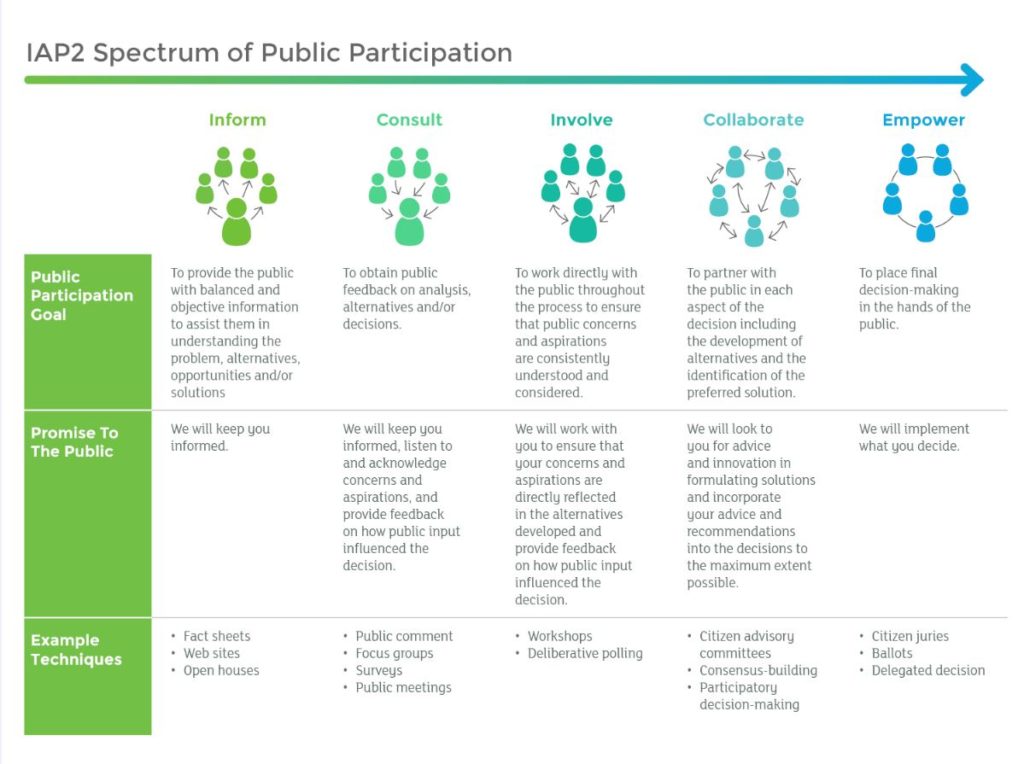Part 3: The Medium
3.6 Stakeholder Engagement
Learning Objectives
- To understand why and whether you should engage stakeholders in your communication program.
- To have an overview of stakeholder engagement techniques.
- To describe some considerations for successful stakeholder engagement.

Stakeholder engagement uses face-to-face (F2F) communication to build a relationship with stakeholders—those who are likely to have an influence on and/or be impacted by the initiative. The purpose of engaging stakeholders is to foster support, receive feedback and demonstrate accountability. Through building trust and shared understanding between a communicator and key stakeholders, a communication campaign can more effectively achieve its objectives while mitigating potential risks. Additionally, in acknowledging the needs of all stakeholders, a program can be more equitable and responsive to a broader swath of its intended audience.
Should you engage?
Encouraging stakeholder participation during communication planning can help to make sure the actual program will reach the intended audience. However, as discussed in the ethics section, communicators who are consulting stakeholders only for the optics rather than finding ways to create appropriate, meaningful and reciprocal dialogue, can do more harm than good. In short, poorly done stakeholder engagement is often worse than no stakeholder engagement at all.
Therefore, before you start down this path, ask yourself the following questions:
- Is it possible to engage your key stakeholders?
For issues that impact a huge number of people spread over a wide geographic area, it will be an enormous challenge to have full representation of your stakeholders at the table. In addition, such a diverse group will not likely reach consensus. Instead, consider sessions to inform audiences about upcoming activities that may interest them and anticipate and address issues that could incite hostility. - Will stakeholder feedback have any influence over decision making?
If your stakeholders have little say in decisions around a particular policy or program, conducting highly involved engagement sessions could create unrealistic expectations among stakeholders about the final results. - Do you have the necessary resources?
Effective stakeholder engagement will require a significant investment of time, people and money. Make sure to identify the inputs needed for engagement early on in communication planning. Also be sure that everyone in the organization understands the importance of the engagement and will commit to actively listening to participants.
If you conclude there is a need and ability to conduct meaningful stakeholder engagement for your communication program, you will then need to create a plan for how you will conduct those engagements.
Stakeholder analysis
The first step to stakeholder engagement is to actually find out who your key stakeholders are! This involves asking two simple questions: first, who will be impacted by your program; and second, who exerts influence over your program? Create a list of all groups who fall under either, or both, of those categories.
Once you have your list, map out the profiles of each group by determining their interests, their stance with respect to your program and how you will engage them. This is usually done using a stakeholder analysis matrix, such as the one below.
| STAKEHOLDER GROUP | LEVEL OF IMPACT/INFLUENCE | LEVEL OF SUPPORT | INTERESTS | ENGAGEMENT TECHNIQUE |
|---|---|---|---|---|
| Stakeholder 1 | High/Moderate/Low
Impact/Influence |
Supportive/Neutral/Resistant | Needs and expectations | Appropriate ways to be engaged |
| Stakeholder 2 | … | … | … | … |
Table adapted from GoLeanSixSigma.com.
Stakeholder engagement techniques
A key part of stakeholder analysis involves identifying the best technique or suite of techniques to engage each stakeholder group. The techniques you choose will depend on each stakeholder’s communication preferences, the level to which that group should be engaged and your objective for engaging that group.
The International Association for Public Participation has constructed a spectrum of public participation that is a useful tool in planning stakeholder engagement. The spectrum ranges from ‘inform’ (the lowest level of engagement) to ‘empower’ (the highest level). Your engagement objective, and therefore where on the spectrum your engagement efforts will fall, can help to inform the most appropriate techniques to use. The IAP2 Spectrum of Public Participation
The IAP2 Spectrum of Public Participation
In addition to the examples listed in the IAP2 spectrum, other engagement techniques include conversation mapping, Socratic circles, community visioning, dotmocracy, and stop-start-continue exercises.
Additional considerations for stakeholder engagement
Before you launch your stakeholder engagement session, be sure to do an overall assessment of your plan. You should ask yourself:
- Will you get representation from all key stakeholders?
In other words, are those who will be most impacted, or have the most impact on your communication program, able to meaningfully engage? Not only should you have reached out to all the relevant groups, you should make sure your engagement efforts consider accessibility of location, timing, space and language for each of the groups identified.
- Have you selected the appropriate attendees from both sides of the table?
The stakeholder representatives you invite should have the political, organizational, or social authority to represent their group. Meanwhile, your team should include both subject area experts and key decision makers. Additionally, you may require a neutral moderator to facilitate the engagement.
- Have you selected the most appropriate techniques based on the needs of your stakeholders?
Consider the strengths and drawbacks of each technique. For example, while advisory groups can offer feedback over a long period of time, this technique is also time consuming and requires a high level of commitment and interest among participants. Conversely, online surveys are quick to complete and can reach a wide audience but they often have low completion rates and offer shallow information.
- Have you set clear terms of engagement?
Make sure everyone is clear on and in agreement about both the objectives and process of the engagement. Ideally, these terms should be established collaboratively and prior to the initial meeting.

Takeaways
Key Takeaways
- The purpose of engaging stakeholders is to foster support with, receive feedback from, and demonstrate accountability to groups that will be affected by or have impact on your communication project.
- Before engaging stakeholders, carefully reflect on whether engagement is feasible and appropriate.
- Plan your stakeholder engagement by mapping out your key stakeholder groups and selecting the engagement techniques that reflect the preferences of that group and your communication goals.


